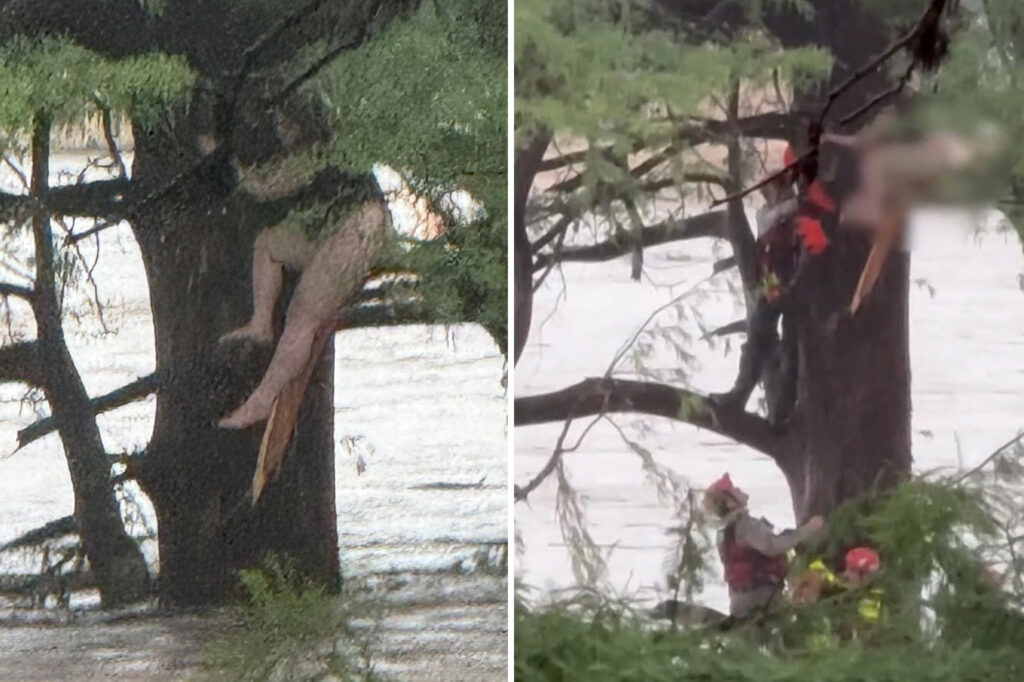
A 22 year old woman was rescued from clinging to a tree by first responders amidst the surging flash floodwaters of the Guadalupe River. Reports say that she washed many miles downstream from Ingram, Texas, to Kerrville where a Good Samaritan heard her cries for help. = https://www.facebook.com/News4SA/posts/girl-who-was-in-tree-traveled-12-miles-down-river-carl-jeter-in-center-point/1187155606788347/
In a dramatic rescue captured on video, a 22-year-old woman was saved after being swept 20 miles down the Guadalupe River during the devastating Fourth of July floods in Texas. The woman was found clinging to a Cypress tree, several feet above the raging floodwaters, in a harrowing scene reported by KEN5S.
The incident unfolded when a homeowner in Center Point heard the woman’s desperate cries for help. Responding quickly, he discovered her precarious position in the tree, with branches breaking under the strain of the flood. “I hear you, I see you,” he reassured her, despite receiving no response from an overwhelmed 911 system. Instead, he flagged down first responders conducting nearby search and rescue operations.
Rescue Efforts Amidst Chaos
Rescue teams, already stretched thin by the ongoing disaster, were able to reach the woman using boats. By the time they arrived, the floodwaters had receded by about 10 feet, compelling her to jump from the tree into the safety of the boat. Miraculously, she survived with only minor injuries, including scrapes and bruises.
The woman had been camping with her family at a site in Ingram when the surging river swept her from her tent. Her family attempted to flee in a vehicle, which was also carried away by the floodwaters. The fate of her family remains uncertain.
Tragic Losses and Community Impact
The floods, which have claimed at least 25 lives and left dozens missing, have devastated the local community. Among the deceased are two young campers from Camp Mystic, a Christian sleepaway camp for girls. The tragedy has prompted widespread grief and a call for increased safety measures in flood-prone areas.
“The floods have been catastrophic, affecting not only the infrastructure but also the lives of countless families,” said a local emergency official.
Historical Context and Future Implications
Texas is no stranger to severe weather events, with its history marked by significant floods. The current disaster echoes past events, such as the 1921 Central Texas floods, which reshaped local flood management policies. Experts suggest that climate change may be exacerbating the frequency and intensity of such events.
As the community grapples with the aftermath, questions arise about preparedness and response strategies. The overwhelmed emergency hotline during the incident highlights the need for improved systems to handle such crises effectively.
“We need to rethink our emergency response frameworks to better protect our communities,” noted a disaster management expert.
Looking Ahead: Recovery and Resilience
In the wake of this disaster, recovery efforts are underway, with local authorities and volunteers working tirelessly to provide relief to affected families. The focus now shifts to rebuilding and enhancing resilience against future floods.
As Texas rebuilds, the resilience of its communities will be tested. The lessons learned from this tragedy could pave the way for more robust disaster preparedness and response strategies, ensuring that future generations are better protected.
The woman’s survival story amidst such adversity serves as a poignant reminder of the human spirit’s resilience and the critical importance of community support during times of crisis.





